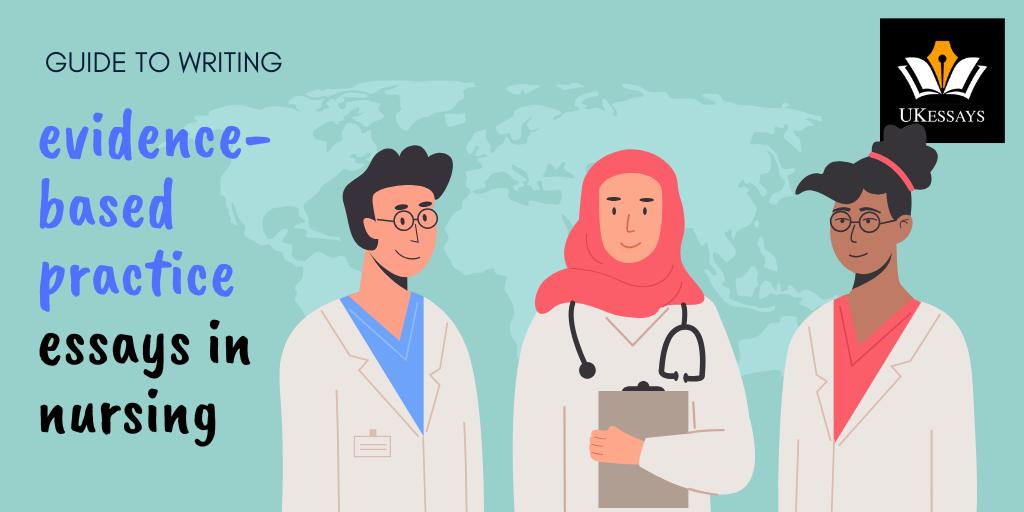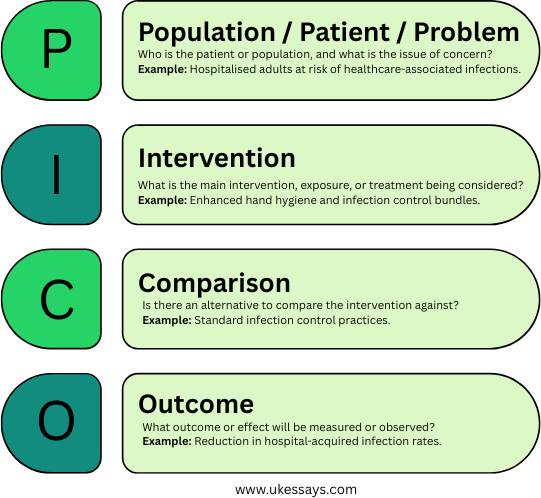Guide to writing evidence-based practice essays in nursing
Info: 2859 words (11 pages) Study Guides
Published: 08 Oct 2025

Need help mastering your evidence-based practice assessment? Get expert nursing assignment support and submit with confidence today. See our nursing assignment help page for more info.
Evidence-based practice essays are a common assignment in nursing courses. They require students to review current research literature and clinical guidelines to demonstrate an understanding of best practices in patient care.
These essays go beyond simple summaries – they demand critical analysis of research findings and thoughtful discussion of how the evidence can inform real-world nursing practice.
Understanding evidence-based practice essays
An evidence-based practice essay focuses on a specific clinical question or topic, using up-to-date evidence to answer that question and guide nursing practice. In essence, evidence-based practice is about integrating the best available research evidence with clinical expertise and patient values when making decisions (Straus et al. 2011).
Nursing students are expected to find relevant scholarly sources – such as peer-reviewed journal articles, systematic reviews, or clinical guidelines – and critically appraise them. Crucially, an evidence based practice essay is not just a literature review; it must also analyse the quality of evidence and discuss its implications for patient care.
Evidence-based practice is central to modern nursing. The Nursing and Midwifery Council Code emphasises that nurses must deliver care “based on the best evidence and best practice” (NMC 2018). Likewise, the World Health Organization notes that EBP leads to improved care quality, better patient outcomes and increased safety (Jylhä et al. 2017).
These essays therefore test a student’s ability to apply that professional mandate. By writing an evidence-based practice essay, you demonstrate that you can not only find pertinent evidence on a nursing topic but also evaluate its reliability and relate it to clinical decision-making.
Planning your evidence-based practice essay
Clarify the assignment question:
Begin by carefully examining the essay prompt or clinical scenario. EBP essay questions often include two parts – for example: “Evaluate current evidence on preventing hospital-acquired infections and discuss implications for nursing practice.”
Here, you know you must review research on infection prevention and apply it to nursing practice. It is essential to identify the key terms or variables in your topic (in this case, “hospital-acquired infections” and “nursing practice implications”). Make sure you understand exactly what is being asked so your essay stays focused.
Formulate a focused question:
A helpful strategy is to frame the topic as a clear clinical question using a format like PICO (Population, Intervention, Comparison, Outcome).

For instance, you might ask:
“In hospitalised patients (P), do enhanced hand hygiene and infection control protocols (I) compared to standard practices (C) reduce the rate of hospital-acquired infections (O)?”
Formulating a precise question will guide your literature search and ensure you seek evidence that directly addresses the assignment. A well-defined question also prevents the essay from becoming too broad or vague (Aveyard and Sharp 2009). It provides a strong foundation for gathering and organising your content.
Conduct a thorough literature search:
With a focused question in mind, proceed to gather the evidence. Search academic databases and reputable sources such as CINAHL, MEDLINE, PubMed, or Cochrane Library for recent research studies, systematic reviews, and clinical guidelines related to your topic. Use specific keywords from your question (e.g. “hospital-acquired infection prevention”, “infection control nursing guidelines”) to narrow the results.
It is advisable to set inclusion criteria – for example, prioritising recent (last 5–10 years) studies, high-level evidence like systematic reviews or randomised controlled trials, and relevant national or international guidelines. By using rigorous search strategies and inclusion/exclusion criteria, you demonstrate a systematic approach to finding the best evidence (Melnyk and Fineout-Overholt 2015).
Remember to record the details of your search (databases, keywords, filters used) as some assignments expect you to describe your methodology for literature selection.
Select high-quality sources:
Not all information is equally reliable, so be selective. Emphasise peer-reviewed research and authoritative guidelines over opinion pieces or low-quality websites. In evidence hierarchies, well-conducted systematic reviews and randomised controlled trials (RCTs) are regarded as the most robust sources for clinical interventions (Melnyk and Fineout-Overholt 2015).
For example, if looking at infection prevention, a Cochrane review on hand hygiene or a meta-analysis of infection control bundles would carry more weight than a small, single-hospital study.
That said, include a range of evidence types if appropriate – qualitative studies, observational research, or expert consensus can be useful for certain topics or for providing context.
When selecting evidence, aim to balance quantitative and qualitative sources where appropriate.
Quantitative studies, such as randomised controlled trials and cohort analyses, provide measurable data on effectiveness, while qualitative research offers insight into patients’ experiences, staff perspectives, and contextual factors influencing practice.
In areas such as communication, pain management, or adherence to care plans, qualitative findings can be just as valuable as statistical outcomes for shaping evidence-based decisions. A strong EBP essay demonstrates awareness of both types of evidence and explains how they complement one another in guiding nursing care.
Check that each source is current, credible and relevant to your question. Clinical guidelines from recognised bodies (such as NICE or the CDC) are particularly valuable, as they distil a broad evidence base into practical recommendations.
Critically appraising the evidence
Gathering evidence is only half the task; the other key skill in an EBP essay is critical appraisal. You must analyse and critique the quality of the studies and documents you have found, rather than simply accepting their findings at face value.
This involves asking probing questions about each source:
- How rigorous was the study design?
- Are the sample sizes large enough to support the conclusions?
- Did the researchers control for biases and confounding factors?
- Are the results statistically and clinically significant?
For literature reviews or guidelines, consider whether they included all relevant research and whether their recommendations are consistent with the evidence presented.
Using established appraisal tools can add structure to your critique. For instance, the Critical Appraisal Skills Programme provides checklists for evaluating research articles methodically (CASP 2018). Applying such a framework helps ensure you comment on important aspects of validity and reliability.
In your essay, you might note strengths and limitations of each study. For example:
“Smith et al. (2020) conducted a randomised trial on hand hygiene education; the RCT design strengthens the level of evidence, but the study’s limitation was a small sample size of only 50 patients, which may affect generalisability.”
By comparing multiple sources, you can identify consensus or discrepancies in findings. If two high-quality studies have conflicting results, discuss possible reasons (such as different patient populations or methodologies) and weigh which evidence seems more robust. This critical analysis component is crucial: it shows that you understand not all evidence is equal and that you can discern what findings are most trustworthy (Melnyk and Fineout-Overholt 2015).
When appraising evidence, also consider how directly it applies to your specific nursing context or population. A study in an intensive care unit may have different applicability to a general ward.
Similarly, be mindful of any gaps in the evidence. If you find little high-level research on a sub-topic, acknowledge that the practice might rely on lower-level evidence or clinical expertise in the meantime. Being honest about limitations in the evidence base (and in your analysis) reflects a mature, scholarly approach.
Organising and writing the essay
With your evidence gathered and appraised, the next step is to structure and write the essay in a clear, logical format. An effective evidence-based practice essay typically follows a standard academic layout:
Introduction:
Start with a strong introduction that sets the stage for your topic. Provide brief background context on why the clinical issue is important. For example, if writing about hospital-acquired infections, you might mention their prevalence and impact on patient morbidity.
Clearly state the aim of your essay – for instance, “to evaluate current evidence on preventing hospital-acquired infections and explore the implications for nursing practice.”
It is often helpful to include a concise thesis statement that outlines the central argument or finding. The introduction should engage the reader and signpost what will follow, while remaining concise.
In an EBP essay, you may also briefly define key terms or the scope (e.g. focusing on adult acute care settings, if that’s the case). Ensure the introduction flows naturally into the main body.
Literature review and critical analysis (Main body):
This is the core of your essay. Organise the main body into coherent paragraphs or subsections that each cover a specific aspect of the topic. One common approach is to structure it thematically – for example, if the question is about preventing infections, you might have separate sections on hand hygiene, use of personal protective equipment, environmental cleaning, and antibiotic stewardship, since these are all key evidence-based strategies for infection control. Under each theme, synthesize the findings from the sources you gathered.
Summarise what the evidence says, compare studies, and critically analyse as discussed above. Aim to integrate sources rather than discussing each article in isolation – for instance, you could write:
“Evidence-based guidelines and multiple studies indicate that comprehensive hand hygiene protocols significantly lower infection rates (NICE 2017; Al-Maani et al., 2022). However, compliance remains a challenge – Al-Maani et al. (2022) found that while adherence rose to 74.1% three months after implementation, it declined to 70.0% at 15 months, highlighting the difficulty of sustaining improvement without ongoing education. This suggests that evidence-based guidelines must be paired with regular staff training and audits to maintain their long-term impact.”
In this way, you are not just listing findings but interpreting them and relating them to practical considerations.
Maintain a critical tone: support every claim with evidence and cite sources in Harvard style (Author Year).
If some evidence is stronger or more applicable, emphasise that.
Use transition words to ensure the argument flows – for example, “furthermore,” “on the other hand,” “in contrast,” “similarly,” etc., to connect ideas. This makes it easier for the reader to follow the logic of your analysis.
Also, be clear when you are interpreting or extrapolating from the evidence. For instance, you might say: “The data from these ICU studies likely generalise to other hospital settings, although certain interventions may need tailoring to each ward’s context.” Such qualifiers show critical thinking.
Keep paragraphs focused and not overly long (each should address one main point or theme).
Remember to write mostly in an active voice for clarity and impact – e.g. “The nurse can implement X” rather than “X can be implemented by the nurse.” Active phrasing tends to be more direct and engaging.
Implications for nursing practice:
A crucial element of an EBP essay is linking the evidence back to clinical practice, as often explicitly required by the assignment. After evaluating the literature, dedicate a section (or integrated paragraphs) to discuss what these findings mean for nursing practice. This is where you answer the “So what?” question.
Consider how nurses can apply the evidence at the bedside or within their healthcare organisations. Continuing the example on infection prevention: if the evidence showed that daily chlorhexidine bathing reduces bloodstream infections in ICU patients, discuss how nurses might incorporate that into standard care, or what policies might need updating. If guidelines (like those from NICE or the CDC) already exist, mention how adhering to these evidence-based guidelines can improve outcomes.
For instance, you could write:
“Current national guidelines align with these research findings. NICE (2017) emphasises rigorous hand decontamination, appropriate use of personal protective equipment, safe sharps disposal, and adherence to other standard precautions as essential measures to prevent healthcare-associated infections. In practice, nurses should ensure these protocols are consistently applied within their units, while nurse leaders are encouraged to conduct regular audits and provide feedback to sustain high compliance levels.”
By referencing best-practice guidelines and showing how research evidence underpins them, you demonstrate an understanding of the continuum from evidence to practice. Additionally, consider any barriers to implementation.
Real-world factors (like resource constraints, staff training needs, or patient preferences) can influence how easily an evidence-based intervention is adopted. A top-scoring essay will acknowledge such issues.
For example:
“Although evidence supports use of urinary catheter reminders to cut infection rates, implementing this change may require staff education and support from hospital management. Nurse educators have a role in highlighting the evidence to frontline staff and addressing concerns, so that practice can shift in line with research.”
By discussing implementation, you show a practical grasp of nursing that goes beyond theory.
Conclusion:
Conclude the essay with a clear summary of the key findings from your evidence review and reiterate the implications for nursing. A strong conclusion will tie back to your introduction and thesis, confirming how the assignment question was answered.
Avoid introducing new evidence or arguments in the conclusion. Instead, synthesise what has been learned. For instance:
“In summary, this essay has evaluated current evidence on preventing hospital-acquired infections. Robust research indicates that a bundle of interventions – including strict hand hygiene, environmental cleaning, judicious use of devices, and antibiotic stewardship – can dramatically reduce infection rates. For nurses, this evidence underlines the importance of adhering to infection control protocols and advocating for system-wide support of best practices. By critically appraising the literature and applying it to care, nurses can lead improvements in patient safety.”
End on a confident note about the value of evidence-based practice in enhancing care. A reader should finish the essay with a clear understanding of what actions or changes the evidence suggests, and why those are important.
Writing style and academic integrity
Throughout your essay, maintain a formal academic tone and write in clear, concise sentences.
Use transition words to improve flow and coherence between ideas – terms like “however”, “therefore”, “moreover” and “for example” guide the reader through your reasoning.
Aim for a balance of sentence lengths: mixing shorter and longer sentences can make the text more engaging and readable.
Importantly, use the active voice wherever possible to strengthen your statements. For example, write “Researchers observed a reduction in infection rates” instead of “A reduction in infection rates was observed”. Active voice construction not only reduces wordiness but also makes it clear who is performing an action, thereby enhancing clarity. Limit the use of passive constructions to less than 10% of your sentences, in line with good writing practice.
Be sure to paraphrase information from your sources and give credit through proper citations. Every claim that comes from a source should be followed by a citation. This not only upholds academic honesty by avoiding plagiarism, but also allows the reader to locate the evidence you are referencing.
For example:
“According to Stone et al. (2008), and reinforced by more recent systematic reviews, higher nurse staffing levels are generally associated with lower rates of healthcare-associated infections.”
In this sentence, the citation tells the reader exactly where that evidence came from. Follow your institution’s guidelines on referencing; typically, Harvard style means in-text citations and a corresponding reference list at the end of your essay. Do not include URLs in the body text – just the author(s) and year – since full details (including any web links) will appear in the reference list.
Use our free referencing generators to get your citations perfect:
- Harvard referencing generator
- APA referencing generator (7th edition)
Finally, ensure that your essay is well-presented and proofread. Adhere to any formatting requirements (such as word count or specific headings) given by your course.
Use sentence case for headings (only the first letter capitalised) and a logical heading hierarchy (for instance, main sections as Level 2 headings, with any sub-points as Level 3).
Keep your paragraphs focused and not overly long – large blocks of text can overwhelm the reader, so it is better to have a new paragraph for a new idea or theme, keeping paragraphs roughly under 150 words.
Before submission, revise your draft for clarity, flow and grammatical accuracy. Pay attention to transition wording and sentence rhythm: the goal is a professional yet readable style. Reading the essay aloud or using a text-to-speech tool can help catch any awkward phrasing or overly long sentences.
If you would like an extra pair of eyes to check over your essay, consider using our editing service. Avoid using tools which polish your text to the degree that it can be flagged as AI-generated – human editing is far less risky!
Need help mastering your evidence-based practice assessment? Get expert nursing assignment support and submit with confidence today. See our nursing assignment help page for more info.
References and further reading:
- Aveyard, H. and Sharp, P. (2009) A beginner’s guide to evidence-based practice in health and social care professions. Maidenhead: Open University Press.
- Critical Appraisal Skills Programme (CASP) (2018) CASP Checklists. Available at: https://casp-uk.net/casp-tools-checklists/ (Accessed 10 July 2025).
- Jylhä, V., Oikarainen, A., Perälä, M-L. and Holopainen, A. (2017) Facilitating evidence-based practice in nursing and midwifery in the WHO European Region. Copenhagen: World Health Organization Regional Office for Europe.
- Melnyk, B.M. and Fineout-Overholt, E. (2015) Evidence-based practice in nursing & healthcare: A guide to best practice. 3rd edn. Philadelphia: Wolters Kluwer.
- National Institute for Health and Care Excellence (NICE) (2017) Healthcare-associated infections: prevention and control in primary and community care (Clinical Guideline 139). London: NICE.
- Nursing & Midwifery Council (NMC) (2018) The Code: Professional standards of practice and behaviour for nurses, midwives and nursing associates. London: NMC.
- Straus, S.E., Glasziou, P., Richardson, W.S. and Haynes, R.B. (2011) Evidence-Based Medicine: How to Practice and Teach It. 4th edn. Edinburgh: Churchill Livingstone.
Cite This Work
To export a reference to this article please select a referencing stye below:



